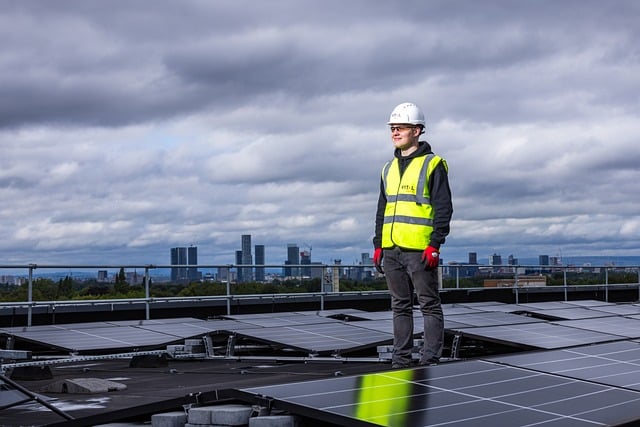“Master Your Solar Inverter: Troubleshoot Like a Pro!”
Troubleshooting common solar inverter issues is essential for maintaining the efficiency and longevity of solar energy systems. Inverters play a crucial role in converting the direct current (DC) generated by solar panels into alternating current (AC) for use in homes and businesses. However, like any electronic device, inverters can encounter problems that may disrupt energy production. Understanding the typical issues that arise, such as error codes, performance drops, and connectivity problems, is vital for both homeowners and technicians. This guide will provide a comprehensive overview of common solar inverter issues, practical troubleshooting steps, and tips for ensuring optimal performance, empowering users to address problems like a pro.
Identifying Common Solar Inverter Error Codes
When it comes to solar energy systems, the inverter plays a crucial role in converting the direct current (DC) generated by solar panels into alternating current (AC) that can be used in homes and businesses. However, like any electronic device, solar inverters can encounter issues that may disrupt their performance. One of the first steps in troubleshooting these problems is understanding the common error codes that inverters display. By familiarizing yourself with these codes, you can quickly identify the underlying issues and take appropriate action.
Many solar inverters are equipped with a digital display or an app that shows error codes when something goes wrong. These codes can vary by manufacturer, but several common ones appear across different models. For instance, a “Grid Disconnect” error indicates that the inverter has lost connection with the electrical grid. This could be due to a power outage or a fault in the grid itself. In such cases, it is essential to check local grid conditions and ensure that the inverter is set to reconnect automatically once the grid is stable again.
Another frequent error code is the “Overvoltage” warning. This occurs when the voltage from the solar panels exceeds the inverter’s maximum input threshold. Overvoltage can be caused by several factors, including excessive sunlight or a malfunctioning panel. To address this issue, inspect the solar array for any damaged panels or wiring and ensure that the system is properly configured to handle the voltage levels produced during peak sunlight hours.
Conversely, an “Undervoltage” error indicates that the voltage is too low for the inverter to operate efficiently. This can happen during cloudy weather or if there is a significant drop in solar production. In such cases, it is advisable to monitor the weather conditions and allow the system to recover naturally. If the problem persists, it may be necessary to check the connections and ensure that all components are functioning correctly.
In addition to these voltage-related issues, inverters may also display “Temperature” error codes. These codes signal that the inverter is overheating, which can lead to reduced efficiency or even permanent damage. Overheating can result from poor ventilation, excessive dust accumulation, or prolonged exposure to high temperatures. To mitigate this risk, ensure that the inverter is installed in a well-ventilated area and regularly clean any dust or debris that may obstruct airflow.
Another common error code is related to “Communication Failures.” This indicates that the inverter is unable to communicate with other system components, such as the monitoring system or the solar panels. Communication issues can arise from faulty wiring, software glitches, or even network problems. To resolve this, check all connections and consider resetting the inverter or updating its firmware if necessary.
Lastly, it is essential to be aware of “Isolation” errors, which indicate that the inverter has detected a fault in the electrical isolation of the system. This could pose a safety risk, and it is crucial to address it immediately. In such cases, it is advisable to consult a qualified technician to inspect the system thoroughly.
By understanding these common solar inverter error codes, you can troubleshoot issues more effectively and ensure that your solar energy system operates at peak performance. Regular monitoring and maintenance, combined with a proactive approach to identifying and resolving errors, will not only enhance the longevity of your inverter but also maximize the benefits of your solar investment.
Steps to Resolve Overheating Issues in Solar Inverters

Overheating issues in solar inverters can significantly impact the efficiency and longevity of your solar energy system. When an inverter overheats, it may shut down to protect itself, leading to a loss of power generation and potential damage. Therefore, understanding how to troubleshoot and resolve these overheating issues is essential for any solar system owner. The first step in addressing overheating is to identify the underlying causes. Common culprits include inadequate ventilation, excessive ambient temperatures, and overloading the inverter with more power than it can handle.
To begin troubleshooting, check the installation location of your inverter. Ideally, solar inverters should be installed in a shaded, well-ventilated area. If the inverter is located in a confined space or direct sunlight, consider relocating it to a cooler, more open environment. Additionally, ensure that there is sufficient airflow around the inverter. Dust and debris can accumulate over time, obstructing ventilation openings. Regularly cleaning these areas can help maintain optimal airflow and prevent overheating.
Next, assess the ambient temperature where the inverter is installed. Most inverters have a specified operating temperature range, typically between -13°F and 149°F (-25°C to 65°C). If the surrounding temperature exceeds this range, it can lead to overheating. In such cases, consider installing a fan or air conditioning unit to help regulate the temperature. Alternatively, you might explore the option of relocating the inverter to a cooler area, especially during the hottest months of the year.
Another critical factor to consider is the inverter’s load capacity. Each inverter has a maximum power output it can handle, and exceeding this limit can cause it to overheat. To determine if you are overloading your inverter, review the specifications provided by the manufacturer and compare them to your system’s energy production and consumption patterns. If you find that your energy demands consistently exceed the inverter’s capacity, it may be time to upgrade to a larger inverter or redistribute the load across multiple inverters.
In addition to these preventive measures, monitoring the inverter’s performance can provide valuable insights into its operating conditions. Many modern inverters come equipped with monitoring systems that allow you to track temperature, output, and efficiency in real-time. By regularly checking these metrics, you can identify potential overheating issues before they escalate. If you notice that the inverter frequently operates at high temperatures, it may be necessary to consult with a professional technician who can conduct a thorough inspection and recommend appropriate solutions.
If, after taking these steps, the inverter continues to overheat, it may indicate a more serious internal issue, such as a malfunctioning component or a fault in the inverter’s design. In such cases, it is crucial to contact the manufacturer or a qualified technician for further diagnosis and repair. Attempting to fix internal issues without proper expertise can lead to further damage and void any warranties.
In conclusion, addressing overheating issues in solar inverters requires a systematic approach that includes assessing the installation environment, monitoring performance, and ensuring that the inverter is not overloaded. By taking these proactive steps, you can enhance the efficiency and lifespan of your solar energy system, ensuring that it continues to provide reliable power for years to come.
Troubleshooting Inverter Connection Problems with Solar Panels
When it comes to solar energy systems, the inverter plays a crucial role in converting the direct current (DC) generated by solar panels into alternating current (AC) that can be used in homes and businesses. However, like any technology, solar inverters can encounter connection problems that may disrupt the flow of energy. Understanding how to troubleshoot these issues effectively can save time, money, and frustration.
To begin with, one of the most common connection problems arises from loose or damaged wiring. Over time, the connections between the solar panels and the inverter can become loose due to environmental factors such as temperature fluctuations or physical vibrations. Therefore, it is essential to inspect all wiring and connections regularly. Start by turning off the inverter and disconnecting it from the power source. Once it is safe to do so, visually examine the wiring for any signs of wear, corrosion, or damage. If you notice any loose connections, tighten them carefully, ensuring that you do not overtighten and cause further damage.
In addition to wiring issues, the inverter may also experience problems due to incorrect installation. If the inverter is not installed according to the manufacturer’s specifications, it may not function properly. This can include improper grounding or incorrect orientation. To address this, refer to the installation manual provided by the manufacturer. If you suspect that the installation is not up to standard, it may be wise to consult a professional technician who can assess the situation and make necessary adjustments.
Another common issue is related to the inverter’s settings. Many modern inverters come equipped with various settings that can be adjusted based on the specific requirements of the solar panel system. If these settings are not configured correctly, it can lead to connection problems. To troubleshoot this, access the inverter’s interface, which typically includes a display screen and buttons. Check the settings against the manufacturer’s recommendations and make any necessary adjustments. If you are unsure about the correct settings, consulting the user manual or contacting customer support can provide clarity.
Moreover, environmental factors can also play a significant role in connection problems. For instance, shading from trees, buildings, or debris can affect the performance of solar panels, leading to reduced energy production and potential connection issues with the inverter. To mitigate this, regularly inspect the area around your solar panels and ensure that they are free from obstructions. If necessary, trim back any overhanging branches or remove debris that may be casting shadows on the panels.
Lastly, it is essential to monitor the inverter’s performance regularly. Most inverters come with monitoring systems that allow users to track energy production and identify any anomalies. If you notice a significant drop in energy output, it may indicate a connection problem that requires immediate attention. By staying vigilant and proactive, you can address issues before they escalate into more significant problems.
In conclusion, troubleshooting inverter connection problems with solar panels requires a systematic approach that includes inspecting wiring, ensuring proper installation, adjusting settings, considering environmental factors, and monitoring performance. By following these steps, you can effectively identify and resolve common issues, ensuring that your solar energy system operates efficiently and reliably. With a little knowledge and diligence, you can troubleshoot like a pro and enjoy the benefits of clean, renewable energy without unnecessary interruptions.
How to Fix Battery Charging Issues in Solar Inverter Systems
When it comes to solar inverter systems, battery charging issues can be a significant concern for users, as they directly impact the efficiency and reliability of the entire solar energy setup. Understanding how to troubleshoot these problems effectively is essential for maintaining optimal performance. One of the first steps in addressing battery charging issues is to check the connections. Loose or corroded terminals can impede the flow of electricity, leading to inadequate charging. Therefore, it is crucial to inspect all connections between the solar panels, inverter, and batteries. Ensuring that these connections are clean and secure can often resolve many charging problems.
In addition to checking connections, it is important to assess the condition of the batteries themselves. Over time, batteries can degrade due to age, excessive cycling, or poor maintenance. If the batteries are old or have been subjected to extreme conditions, they may not hold a charge effectively. Testing the voltage of each battery can provide insight into their health. If any battery shows significantly lower voltage than the others, it may need to be replaced. Furthermore, ensuring that the batteries are compatible with the inverter system is vital, as mismatched components can lead to inefficient charging and overall system performance.
Another common issue that can affect battery charging is the solar inverter’s settings. Many modern inverters come equipped with programmable settings that allow users to optimize charging based on their specific needs. If the inverter is not configured correctly, it may not charge the batteries efficiently. Therefore, reviewing the inverter’s manual and adjusting the settings according to the manufacturer’s recommendations can be beneficial. This includes checking parameters such as charging voltage, current limits, and battery type settings. Making these adjustments can significantly enhance the charging process and prolong battery life.
Moreover, environmental factors can also play a role in battery charging issues. For instance, if the solar panels are not receiving adequate sunlight due to shading from trees or buildings, the energy generated may be insufficient to charge the batteries fully. Regularly cleaning the solar panels and ensuring they are positioned optimally can help maximize their exposure to sunlight. Additionally, monitoring the weather conditions and understanding how they affect solar energy production can provide valuable insights into potential charging issues.
If, after checking connections, battery health, inverter settings, and environmental factors, the problem persists, it may be time to delve deeper into the inverter’s functionality. Inverters can experience faults or malfunctions that affect their ability to charge batteries properly. Checking for error codes on the inverter display can provide clues about what might be wrong. If the inverter is under warranty, contacting the manufacturer for support can be a wise course of action. They may offer troubleshooting assistance or service options that can resolve the issue without further complications.
In conclusion, troubleshooting battery charging issues in solar inverter systems requires a systematic approach that involves checking connections, assessing battery health, reviewing inverter settings, and considering environmental factors. By following these steps, users can often identify and rectify common problems, ensuring that their solar energy systems operate efficiently and reliably. With a little patience and attention to detail, anyone can tackle these challenges like a pro, ultimately leading to a more sustainable and effective energy solution.
Q&A
1. **Question:** What should I do if my solar inverter is showing a fault code?
**Answer:** Refer to the inverter’s user manual to identify the fault code and follow the recommended troubleshooting steps, which may include resetting the inverter or checking for issues with the solar panels or wiring.
2. **Question:** Why is my solar inverter not producing any power?
**Answer:** Check for any shading on the solar panels, ensure that the inverter is properly connected to the grid, and verify that the DC input voltage from the panels is within the acceptable range.
3. **Question:** What causes my solar inverter to frequently shut down?
**Answer:** Frequent shutdowns can be caused by overheating, grid voltage fluctuations, or internal faults. Ensure proper ventilation, check grid conditions, and inspect for any signs of damage or wear.
4. **Question:** How can I tell if my solar inverter is functioning properly?
**Answer:** Monitor the inverter’s display for normal operating indicators, check the output power levels against expected values, and use a monitoring app if available to track performance over time.
Conclusion
In conclusion, effectively troubleshooting common solar inverter issues requires a systematic approach that includes understanding the inverter’s indicators, checking connections, monitoring performance data, and ensuring proper maintenance. By familiarizing oneself with the specific inverter model and utilizing diagnostic tools, users can identify and resolve problems efficiently, ensuring optimal system performance and longevity. Regular inspections and prompt attention to any anomalies can prevent minor issues from escalating, ultimately maximizing the benefits of solar energy systems.




